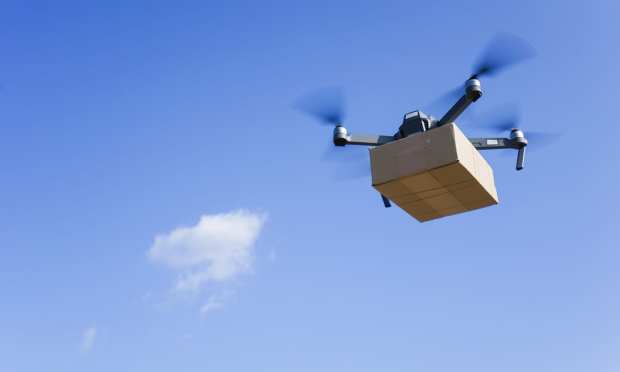Flytrex CEO On Drone Food Delivery: ‘There’s No Better Way’

Food delivery does not work — at least, not yet. Consumers are getting frustrated with the inflated costs, restaurants struggle to make a profit while shouldering the costs of delivery, be it in-house or third-party, and delivery services are up against local regulations, restaurant pushback, a growing awareness among consumers that these services are not always best for the restaurants they love and a shortage of workers willing to go the last mile.
Still, demand for restaurant delivery remains high. In fact, research from PYMNTS’ study, The Bring-It-To-Me Economy: How Online Marketplaces And Aggregators Drive Omnichannel Commerce, created in collaboration with Carat by Fiserv, finds that almost half of all consumers are ordering food for delivery somewhat or much more often now than before the start of the pandemic. The delivery process will need to change dramatically for the digital ordering boom to be sustainable for restaurants. One way that restaurants may be able to make the model work is drone delivery.
“If we’re talking specifically about restaurant meals, there’s no better way,” Yariv Bash, co-founder and CEO of on-demand backyard drone delivery company Flytrex, told PYMNTS in an interview. “The other way that I can think of in terms of robots is … a whole car delivering you a burrito or a hamburger. It just doesn’t make sense in terms of volume and size and weight.”
He added that “those cute robots that drive on the sidewalk” are too slow to deliver restaurant meals in time to meet consumers’ expectations.
In addition to partnering with Walmart on grocery deliveries, Flytrex is also working with quick-service restaurant (QSR) El Pollo Loco to test restaurant meal deliveries and has previously partnered with Starbucks on coffee deliveries.
Make It Work
The biggest challenge ahead for backyard meal delivery via drones is regulations. While the Federal Aviation Administration (FAA) has already approved Flytrex’s drone deliveries in select areas in North Carolina, Bash predicts that approval country-wide for backyard delivery will be coming in the “next half year or so.”
“Once you have that approval, there are a few small limitations, but you can basically start avoiding all over the U.S., which is pretty crazy,” said Bash. “And after that it’s all about educating the market and deploying stations as fast as you can.”
The approval process that Flytrex’s drones are currently undergoing, which has been under way for three years now, is the same one that a Boeing 787 commercial airplane goes through, and it requires the drones to have a range of different failsafe mechanisms and backups to ensure safety.
Debunking The Big 4
Bash believes that consumers’ misconceptions about drones fall into three main areas: safety, noise, privacy and price. The FAA regulations see to the first. Regarding noise, Bash said, while early drone delivery tests brought in noise complaints, Flytrex’s locations in Raeford and Fayetteville, North Carolina have not received any such complaints.
“We’ve designed a system that specifically tailored for backyard deliveries, and part of that was designing a system that’s quiet enough to not interfere with the quiet suburbs,” said Bash.
Concerning privacy, he said the lack of cameras on Flytrex’s drones make them “a lot more private than any other on-demand company.” The machines navigate by satellite.
As far as pricing, Bash said that within the next “six to 12 months,” drones will be “an order of magnitude cheaper than any other on-demand delivery service,” adding that one operator can guide up to 20 deliveries at once and that each drone can do four to six deliveries each hour.
The Right Place At The Right Time
He is not saying that drones will be the right solution for everyone, wherever and however they may live.
“I mean, we’re not going to operate in Manhattan anytime soon,” he said. “It’s just not a very good user experience … You really don’t want to climb to the rooftop or exit the building.”
He added that, for people living in apartment buildings and in congested areas, human delivery works better because you can have the meal brought right to your door. Still, he believes that food delivery will shift dramatically towards drones in the years ahead. He noted that drones “shine a lot brighter” in delivering to private homes.
The Home Stretch
Bash believes that other companies go wrong in rushing too quickly to get into the public eye, running “PR stunts” and beginning operations under the regulations as they stand today, which do not allow the companies to fulfill enough orders to make a profit on backyard delivery.
“Flytrex took a very different approach — we’re considering it a marathon, rather than a sprint,” he said.
He added that the company is building an end-to-end system to support the delivery network, optimizing the process, which, he argues, is what it takes to make, say, a $5 burrito delivery profitable. With this groundwork laid, Bash believes that adoption will be quick, given how convenient the model is.
“I think that once a certification is given, this is going to explode,” Bash said. “It’s going to explode even faster than those mobility scooters that popped up around major cities in the past few years … It’s going to be as easy as Amazon Prime … just click ‘buy now,’ and we’ll deliver it straight to your backyard.”
